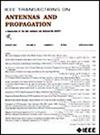Compact 2-D Passive Beam-Scanning Multibeam Antenna Based on Rotman Lens and Mechanical Sweeping Phase Gradient Metasurface
IF 4.6
1区 计算机科学
Q1 ENGINEERING, ELECTRICAL & ELECTRONIC
引用次数: 0
Abstract
A compact multibeam antenna is proposed with passive 2-D beam scanning capability. The antenna is composed of a Rotman lens beamformer, a slotted waveguide array (SWA), and a mechanical sweeping phase gradient metasurface (PGM). The Rotman lens and the PGM together provide a wide range of scanning angles, enabling 2-D beam steering. To improve the crossover level (COL) and the sidelobe level (SLL) of the beams steered by the Rotman lens, the technology of dual sources excitation (DSE) is used, optimizing the COL and the SLL by the tapered magnitude distribution from the sources. Numerical analysis and full-wave simulation are used to verify the performance variations with different source aperture sizes. Since the SWA array can generate a quasi-plane wave above its aperture, the PGM can be fitted close to the SWAs with low spillover loss, resulting in a low antenna profile (基于罗特曼透镜和机械扫描相位梯度超表面的紧凑二维无源波束扫描多波束天线
提出了一种具有被动二维波束扫描能力的紧凑型多波束天线。该天线由罗特曼透镜波束形成器、开槽波导阵列(SWA)和机械扫频相位梯度超表面(PGM)组成。罗特曼透镜和PGM一起提供大范围的扫描角度,实现二维光束转向。为了提高罗特曼透镜引导光束的交叉电平(COL)和旁瓣电平(SLL),采用了双源激励(DSE)技术,通过源的锥度分布来优化交叉电平和旁瓣电平。通过数值分析和全波仿真验证了不同声源孔径下的性能变化。由于SWA阵列可以在其孔径以上产生准平面波,因此PGM可以靠近SWA安装,具有低溢出损耗,从而获得低天线轮廓($\lt 0.41\lambda $)。然后,优化PGM的相位分布,抑制边缘负相位突变,进一步优化增益和SLL。为了验证其可行性,设计并制作了5.8 GHz的原型机。测量结果表明,在多波束和PGM机械扫描平面上,可实现±50°和±40°波束扫描范围,最小COL和SLL分别为−2.6和−8.8 dB。该天线具有广角二维波束扫描范围、低SLL和COL,在低成本传感和通信应用中具有吸引力。
本文章由计算机程序翻译,如有差异,请以英文原文为准。
求助全文
约1分钟内获得全文
求助全文
来源期刊
CiteScore
10.40
自引率
28.10%
发文量
968
审稿时长
4.7 months
期刊介绍:
IEEE Transactions on Antennas and Propagation includes theoretical and experimental advances in antennas, including design and development, and in the propagation of electromagnetic waves, including scattering, diffraction, and interaction with continuous media; and applications pertaining to antennas and propagation, such as remote sensing, applied optics, and millimeter and submillimeter wave techniques

 求助内容:
求助内容: 应助结果提醒方式:
应助结果提醒方式:


